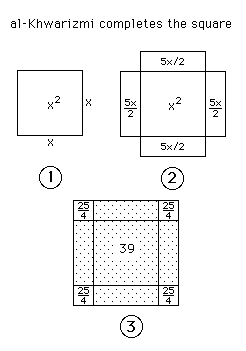حساب الجبر و المقابلہ
Abu Ja'far Muhammad ibn Musa al-Khwarizmi:
The treatise Hisab al-jabr w'al-muqabala was the most famous and important
of all of al-Khwarizmi's works. In this book, which has given us the word
'algebra', al-Khwarizmi gives a complete solution to all possible types of
quadratic equation.
His equations are linear or quadratic and are composed of units, roots and
squares. For example, to al-Khwarizmi a unit was a number, a root was x, and
a square was x2. However,
although we shall use the now familiar algebraic notation in this article to
help the reader understand the notions, Al-Khwarizmi's mathematics is done
entirely in words with no symbols being used.
He first reduces an equation (linear or quadratic) to one of six standard
forms:
1. Squares equal to roots.
2. Squares equal to numbers.
3. Roots equal to numbers.
4. Squares and roots equal to numbers; e.g. x2 + 10 x = 39.
5. Squares and numbers equal to roots; e.g. x2 + 21 = 10 x.
6. Roots and numbers equal to squares; e.g. 3 x + 4 = x2.
The reduction is carried out using the two operations of al-jabr and al-muqabala.
Here "al-jabr" means "completion" and is the process of removing negative
terms from an equation. For example, using one of al-Khwarizmi's own
examples, "al-jabr" transforms x2 = 40 x - 4 x2 into 5 x2 = 40 x. The term
"al-muqabala" means "balancing" and is the process of reducing positive
terms of the same power when they occur on both sides of an equation. For
example, two applications of "al-muqabala" reduces 50 + 3 x + x2 = 29 + 10 x
to 21 + x2 = 7 x (one application to deal with the numbers and a second to
deal with the roots).
Al-Khwarizmi then shows how to solve the six standard types of equations. He
uses both algebraic methods of solution and geometric methods. For example
to solve the equation x2 + 10 x = 39 he writes :-
... a square and 10 roots are equal to 39 units. The question therefore in
this type of equation is about as follows: what is the square which combined
with ten of its roots will give a sum total of 39? The manner of solving
this type of equation is to take one-half of the roots just mentioned. Now
the roots in the problem before us are 10. Therefore take 5, which
multiplied by itself gives 25, an amount which you add to 39 giving 64.
Having taken then the square root of this which is 8, subtract from it half
the roots, 5 leaving 3. The number three therefore represents one root of
this square, which itself, of course is 9. Nine therefore gives the square.
 The geometric proof by completing the square follows. Al-Khwarizmi starts
with a square of side x, which therefore represents x2 (Figure 1). To the
square we must add 10x and this is done by adding four rectangles each of
breadth 10/4 and length x to the square (Figure 2). Figure 2 has area x2 +
10 x which is equal to 39. We now complete the square by adding the four
little squares each of area 5/2 5/2 = 25/4. Hence the outside square in Fig
3 has area 4 25/4 + 39 = 25 + 39 = 64. The side of the square is therefore
8. But the side is of length 5/2 + x + 5/2 so x + 5 = 8, giving x = 3.
The geometric proof by completing the square follows. Al-Khwarizmi starts
with a square of side x, which therefore represents x2 (Figure 1). To the
square we must add 10x and this is done by adding four rectangles each of
breadth 10/4 and length x to the square (Figure 2). Figure 2 has area x2 +
10 x which is equal to 39. We now complete the square by adding the four
little squares each of area 5/2 5/2 = 25/4. Hence the outside square in Fig
3 has area 4 25/4 + 39 = 25 + 39 = 64. The side of the square is therefore
8. But the side is of length 5/2 + x + 5/2 so x + 5 = 8, giving x = 3.
Here is al-Khwarizmi's solution of the equation
x2 + 21 = 10x.
What is most remarkable is that in this case he knows that the quadratic has
two solutions:-
Halve the number of the roots. It is 5. Multiply this by itself and the
product is 25. Subtract from this the 21 added to the square term and the
remainder is 4. Extract its square root, 2, and subtract this from half the
number of roots, 5. There remains 3. This is the root you wanted, whose
square is 9. Alternatively, you may add the square root to half the number
of roots and the sum is 7. This is then the root you wanted and the square
is 49.
Now it is clear that al-Khwarizmi is intending to teach his readers general
methods of solution and not just how to solve specific examples. This is
clear from the was that he continues:-
When you meet an instance which refers you to this case, try its solution by
addition, and if that does not work subtraction will. In this case, both
addition and subtraction can be used, which will not serve in any other of
the three cases where the number of roots is to be halved.
Know also that when, in a problem leading to this case, you have multiplied
half the number of roots by itself, if the product is less than the number
of dirhams added to the square term, then the case is impossible. On the
other hand, if the product is equal to the dirhams themselves, then the root
is half the number of roots

